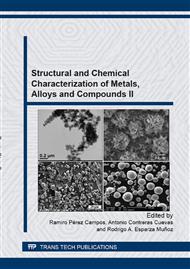[1]
P. Cristiani, A. Franzetti, G. Bestetti, Monitoring of electro active biofilm in soil, Electrochimica Acta 54 (2008) 41-46.
DOI: 10.1016/j.electacta.2008.01.107
Google Scholar
[2]
J.G. Kim, Y.W. Kim, Cathodic protection criteria of thermally insulated pipeline buried in soil, Corrosion Science 43 (2001) 2011-2021.
DOI: 10.1016/s0010-938x(01)00015-4
Google Scholar
[3]
L. Sparks, Environmental Soil Chemistry. Second Edition U.S.A. Elsevier Science 2003.
Google Scholar
[4]
L. Maldonado, L. Veleva, Corrosivity category maps of a humid tropical atmosphere: The Yucatán Peninsula, México, Materials and Corrosion 50 (1999) 261-266.
DOI: 10.1002/(sici)1521-4176(199905)50:5<261::aid-maco261>3.0.co;2-g
Google Scholar
[5]
L. Veleva, G. Pérez and M. Acosta, Statistical analysis of the temperature-humidity complex and time of wetness of a tropical climate in the Yucatan Peninsula in Mexico, Atmospheric Environment 31(1997) 773-776.
DOI: 10.1016/s1352-2310(96)00232-4
Google Scholar
[6]
L. Veleva, L. Maldonado, Classification of the atmosphere corrosivity in the humid tropical climate, British Corrosion Journal 33 (1998) 53-57.
DOI: 10.1179/bcj.1998.33.1.53
Google Scholar
[7]
M. Yan, J. Wang, E. Han, W. Ke, Local environment under simulated disbonded coating on steel pipelines in soil solution, Corrosion Science 50 (2008) 1331-1339.
DOI: 10.1016/j.corsci.2008.01.004
Google Scholar
[8]
L. Quej-Aké, H. Liu, M. A. Espinosa-Medina, E. Sosa-Hernández, 23th National Electrochemical Congress, Mexican Electrochemistry Society (2008).
Google Scholar
[9]
A. Benmoussat and M. Hadjel, Corrosion behavior of low carbon line pipe steel in soil environment, The Journal of Corrosion Science and Engineering 7 (2005) 1-19.
DOI: 10.18321/ectj626
Google Scholar
[10]
C.W. Du, X.G. Li, P. Liang, Z.Y. Liu, G.F. Jia, and Y.F. Cheng, Effects of microstructure on corrosion of X70 pipe steel in an alkaline soil, J. of Mater Eng Performance 18 (2009) 216-220.
DOI: 10.1007/s11665-008-9280-y
Google Scholar
[11]
X.H. Nie, X.G. Li, C.W. Du, Y.F. Cheng, Temperature dependence of the electrochemical corrosion characteristics of carbon steel in a salty soil, J. Appl. Electrochem. 39 (2009) 277-282.
DOI: 10.1007/s10800-008-9669-1
Google Scholar
[12]
D. Gervasio, I. Song, J.H. Payer, Determination of the oxygen reduction products on ASTM A516 steel during cathodic protection, Journal of Applied Electrochemistry 28 (1998) 979-992.
Google Scholar
[13]
J.N. Murray and P.J. Moran, An EIS study of the corrosion behavior of polyethylene coating holidays in natural soil conditions, Corrosion 45 (1989) 885-895.
DOI: 10.5006/1.3584997
Google Scholar
[14]
J.H. Fitzgerald III, Evaluating Soil Corrosivity-Then and now, Materials Performance 49 (1993) 17-19.
Google Scholar
[15]
J.L. Alamilla, E. Sosa, C.A. Sánchez-Magaña, R. Andrade-Valencia, A. Contreras, Failure analysis and mechanical performance of an oil pipeline, Materials and Design 50 (2013) 766-773.
DOI: 10.1016/j.matdes.2013.03.055
Google Scholar
[16]
A. Contreras, S.L. Hernández, R. Orozco-Cruz, R. Galvan-Martínez, Mechanical and environmental effects on stress corrosion cracking of low carbon pipeline steel in a soil solution, Materials and Design 35 (2012) 281-289.
DOI: 10.1016/j.matdes.2011.09.011
Google Scholar
[17]
NACE SP 0169-2007, Control of external corrosion on underground or submerged metallic piping systems, (2007).
Google Scholar
[18]
NACE TM 0497-2002, Measurement technique related to criteria for cathodic protection on underground or submerged metallic piping systems, (2002).
Google Scholar
[19]
ASTM D 4959-2007, Standard test method for determination of water (moisture) content of soil by directs heating (2007).
Google Scholar
[20]
B.A. Boukamp, Users Manual Equivalent Circuit, Version 4.51, Faculty of Chemical Technology, University of Twente, The Netherlands, 1993.
Google Scholar
[21]
J.L. Pikas, Case histories of external microbiologically influenced corrosion underneath disbonded coatings, CORROSION/1996, Paper No. 198, NACE, Denver Co, 1996.
Google Scholar
[22]
F. Kajiyama, K. Okamura, Evaluating cathodic protection reliability on steel pipe in microbially active soils, Corrosion 55 (1999) 74-80.
DOI: 10.5006/1.3283968
Google Scholar


